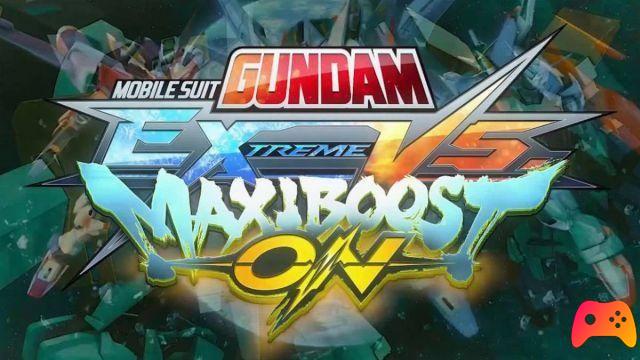We were able to put our hands on Nintendo's latest hardware effort.
Nintendo Switch OLED was announced only a few weeks ago, but immediately it was greeted with some of the extremes to which the videogame landscape has now accustomed us: those who on the one hand accepted it with their eyes closed, childishly confident of the quality of this new console on the other hand those who saw in this new forced iteration only a delay, waiting for that hardware revision seen by many as not only useful, but even necessary.
We do not hide that the writer was a bit 'in the middle, in doubt and relatively skeptical about the actual "necessity" (in quotes because, whatever they say, consoles and video games are still technically luxury goods) of this Nintendo Switch OLED, but ready, as in any other situation, to change your mind. That idea, you'll find out shortly, has actually changed once we could get our hands on the console, in the offices of Nintendo, a few days ago.
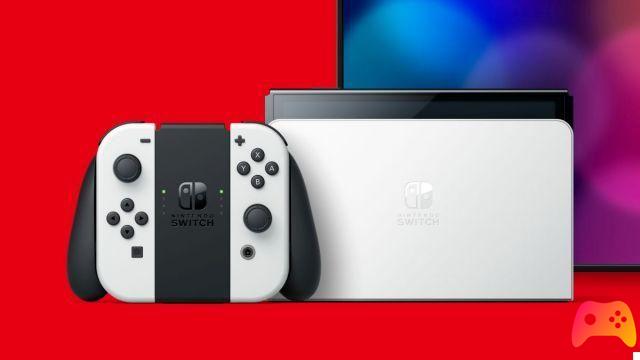
First Impact, aka OLED Screen and Audio
The characteristics of the Nintendo Switch OLED by now we know them by heart, and we knew them clearly when we first glimpsed the console live, but we would lie to you if we said that the stage of our doubts and uncertainties has not collapsed at the moment. speed of light once you see the screen. Yes, the first impact was with the screen, however off, of the Nintendo Switch OLED. Although actually only 0,8 inches (about 2 cm) wider than that of the Nintendo Switch, already when turned off this screen seemed extremely larger and not only that, even better "distributed" along the size of the console.
Once the console was turned on, the surprise was even greater: the OLED screen you can see everything, from the flashiness of the colors to the depth of the blacks, even only in the few elements that make up the UI of the main game menu. Curious to see what Nintendo Switch OLED could still give us, at least in the visual field, we started Mario Kart 8: the impression was to see it with completely new eyes, so as to distract us from the track to get lost in the dark sky of the Electrodome or in the colors of the Dolce Dolce Canyon. The visual satisfaction remains of a high level even on Super Mario Odyssey, however falling a little in front of the color palettes of The Legend Of Zelda: Breath Of The Wild: in this case the reason lies precisely in the aesthetic choices of the title, not on the capacity console itself.
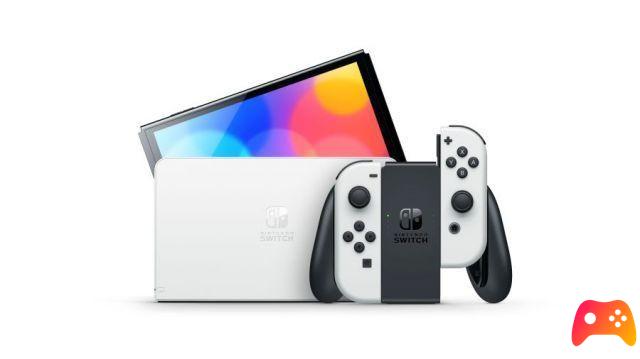
A second aspect that surprised us, immediately after the screen, was the power of the audio: at maximum volume, in portable mode, it was at a volume that gave the impression of being connected to a monitor, using its speakers. to reproduce sounds; the power is really high, and we can imagine how useful this can be when maybe we want to play in a noisy environment and we don't have headphones with us.
Hands-on, literally
In hand Nintendo Switch OLED has "nothing new" to tell: the weight difference it is almost imperceptible, the thickness of the Joy-Con (slightly thinner in this revision of the console) practically identical to before, as the sensation of apparent "fragility" of the console in hand has remained unchanged, daughter of what was already experienced with the first Nintendo Switch. You never get to a cheap effect, mind you, in your hand the Nintendo Switch OLED is and constantly seems to be a premium product, let's just say that some creaking here and there has reopened psychological scars that we thought healed.
Since the announcement, the stand was one of the features that most intrigued the writer, something that greatly affected the table experience of the original Switch: for those who remember it, or for those who still handle it every day, the Nintendo Switch stand does not restitutive the best of the experiences, neither in its use, always too dancer to seem promising properly, nor in its apparent structural solidity. Nintendo Switch OLED raises the bar like never before with a stand that extends over the entire length of the console and that folds up to almost 150 °, allowing practically any table use, for any type of user: we tried different positions and the stand honestly proved to be stable in each of them.
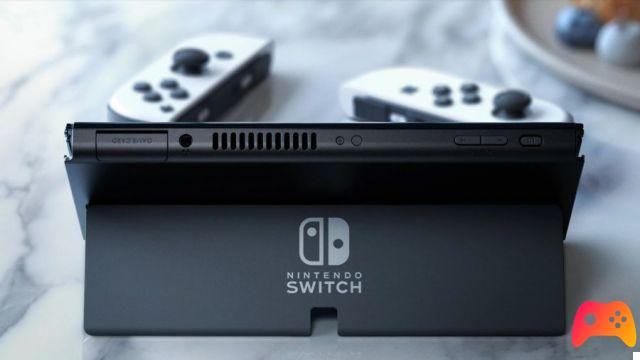
Solidity also bodes well, with a plastic that seemed to us, at all times, strong enough to keep the Nintendo Switch OLED stable but flexible enough to be moved without paying too much attention. Great satisfaction also for the click of returning to the stand.
Learning from mistakes
Without mentioning the Joy-Con drifting, the "flaws" of the first Nintendo Switch are very clear to the community, and one of these was the slight wear that the screen suffered from the front when it was frequently inserted and removed from the dock.
The new dock is more spacious, so much so as to let the Nintendo Switch OLED "dance" in a way that initially worried us and which, with the other hand, still opens up to potential scenarios that worry us a little but that is certainly a strong signal to the community, something that clearly makes it clear that “we are listened to”.
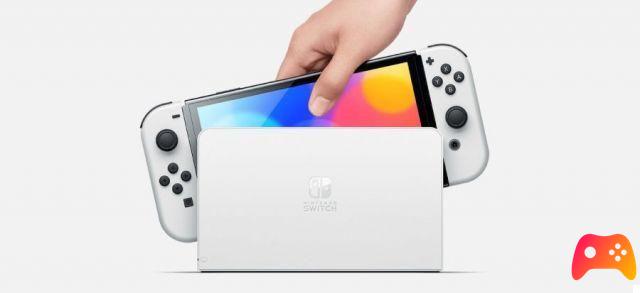
Affordance and small details
Remaining on the dock topic, there is a small evolution also at the structural level, in addition to the addition of the LAN input for more stable connections and more satisfying multiplayer sessions, i.e. the possibility of completely removing the rear housing cover for the cables. It seems a trifle, but it ideally prepares the new Nintendo Switch OLED dock for an unexpected use, something obviously not confirmed in any way by Nintendo, that is, to be able to be… hung.
We know it, we are letting ourselves be tempted from the thoughts arising from the elegance of the black-white dichotomy of this new Switch, but it is an impression that we had so naturally that we cannot help but share it with you who read us.
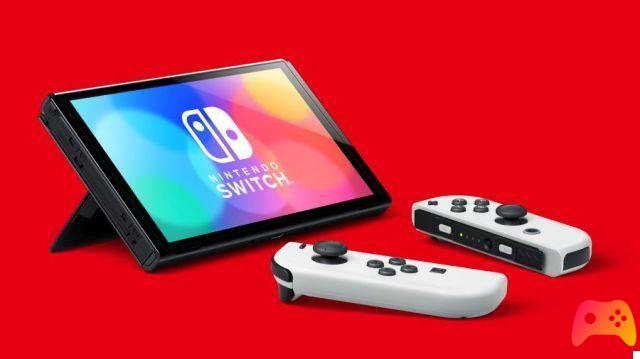
So let's sum up this first hands-on with Nintendo Switch OLED. The doubts that the writer had at the time of the announcement faded very quickly once he was able to experience first-hand what the console means, from those on the actual need for an OLED screen to those resulting from the disappointment towards the choice not to overhaul Switch from the point of view of mere power. The screen is a step forward that can be seen from the first moments, as is the audio power, the revised stand opens up to a very varied spectrum of use and, in its entirety, the Nintendo Switch OLED does not seem the daughter of compromises, which instead Nintendo Switch Lite represented and still represents. The real question that remains is: who is it for? This is an aspect on which, even in the testing phase, we have reasoned a lot: Nintendo Switch Lite is pure portability, with its relative limits; Nintendo Switch is versatility, with the needle of the balance slightly biased towards docked mode; Nintendo Switch OLED wants to cut out a new target, that of the player who uses it in portability but who does not want to give up the visual fidelity and the power of the audio that the connection to a TV already guarantees.
This on the one hand reassures those who are already owners of Nintendo Switch, who should not in any way feel forced to this upgrade to Nintendo Switch OLED, on the other hand it must and it is right that it is one more reason, for all those who have not yet a Switch, to buy this version that seems, voluntarily or not, to be placed at the limit between handheld use and that in table mode.
In short, Nintendo Switch OLED has convinced even the skeptic. The question now is: does it convince and will it convince you too? We just have to wait until October 8 to find out.





